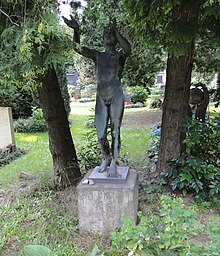Fritz Max Hofmann-Juan
Fritz Max Hofmann-Juan (born July 9, 1873 in Dresden ; † May 31, 1937 there ) was a German painter and graphic artist.
Life
Fritz Max Hofmann-Juan, as he called himself from around 1906, studied at the Art Academy in Dresden and from around 1895 at the Académie Julian in Paris . His teachers in Dresden included Leon Pohle and Ferdinand Pauwels as well as Leonhard Gey and Julius Scholtz . After his return from France in 1910 he belonged to the Munich artist group Sema , of which he was temporarily the first secretary. In 1915 one of his works was praised as “certainly one of the strongest achievements” at the 1914 annual exhibition in the Glaspalast in Munich. He later lived in Dresden, where he came into contact with the Jakob-Böhme-Bund . A trip to India in 1927 gave him lasting inspiration. In the 1930s, his style developed from a more eruptive expressionism to a classical austerity that was reminiscent of Spanish works of the 17th and 18th centuries.
Fritz Max Hofmann-Juan died in Dresden in 1937 and was buried in a community grave at the Loschwitz cemetery . His wife Liddy (1884–1935), the artist Irena Rüther-Rabinowicz , her husband, the artist Hubert Rüther , her second husband and her mother are also buried there; According to Peter Richter , Hofmann-Juan was buried “between his wife, his lover and her husband, standing upright with a pistol and a pack of cigarettes in hand”.
Willy Kriegel created a portrait of Hofmann-Juan . In 2001 an exhibition with pictures from Hofmann-Juan took place in Freital .
Individual works
A lithograph from the time in France is entitled Notre-Dame de Paris . A copy of this 1912 work is in the Los Angeles County Museum of Art . During his stays in Paris, Hofmann-Juan initially developed a style as a painter that came close to that of the French Impressionists. One of his main works from this creative phase is the 81 cm high and 66 cm wide oil painting Frauenraub , which was created around 1910.
Around the same time Fritz Max Hofmann-Juan created several pictures of the Baalbek Sun Temple , one of which he exhibited in Munich in 1911.
The Outdoor Society , a work that apparently at times also bore the title Ruins of a Sanctuary , is likely to have been influenced by Édouard Manet's Breakfast in the Green . Hofmann-Juan painted it in 1922, causing a scandal.
The picture Heiliger Tempelteich belongs to a series of paintings that were shown at the Dresden art exhibition in 1927 and probably represent the high point of Hofmann-Juan's work. He had started his trip to India to restore the frescoes in the temples of Ajanta .
The portrait of the artist Irena Rüther-Rabinowicz is one of the painter's latest works. It shows the painter, who was the first female student to enroll at the Dresden Art Academy in 1919, in elegant clothing in front of the suggested silhouette of Dresden. In the catalog of the Städtische Kunstsammlung Freital this picture is compared with the representational portraits in Spain in the 17th century. Another portrait of the artist, which Hofmann-Juan also created in 1935, shows her in a riding costume in front of a horse.
literature
- Holger Fischer, Rolf Günther: Fritz Hofmann-Juan 1873–1937 . Municipal Collections, Freital 2001 (catalog of the exhibition of the same name, April 8 to May 20, 2001).
- Rolf Günther: Fritz Hofmann-Juan . In: Weltkunst , Vol. 71 (2001), p. 633, ISSN 0043-261X .
Web links
Individual evidence
- ↑ Various artists : Hofmann-Juan, Fritz 1873–1937 ( Memento from August 1, 2012 in the web archive archive.today ), Galerie Königstraße
- ↑ Susanne MI Kaufmann: The "Sema Artists' Association". A group of artists between the expressionist conception of art and the mechanisms of the art market. (PDF; 11.3 MB) LMU Munich, 2008, p. 15 with note 56 , accessed on July 6, 2016 .
- ↑ The art . Monthly books for free and applied arts . tape 31 . F. Bruckmann, Munich 1915, p. 63 ( Textarchiv - Internet Archive ).
- ^ A b Dresden's Jewish artists: Irena Rüther-Rabinowicz. In: Juden-in-Mittelsachsen.de. Retrieved July 6, 2016 .
- ↑ Peter Richter, journalist and writer. In: Saxon newspaper . October 7, 2006, accessed July 6, 2016 .
- ↑ Public resolutions of the city council of the large district town of Freital on June 27, 2007 and July 5, 2007. (No longer available online.) In: freital.de. Archived from the original ; Retrieved July 6, 2016 .
- ↑ Today in the feature sections: FAZ, April 24, 2001. In: Perlentaucher .de. Retrieved July 6, 2016 .
- ↑ Notre-Dame de Paris. In: LACMA Collections. Retrieved July 6, 2016 .
- ^ Hofmann-Juan, Fritz: Notre-Dame de Paris . ( Memento from August 4, 2012 in the web archive archive.today ) Entry in the catalog of the La Vera Pohl Collection of German Expressionism .
- ^ Fritz Max Hofmann-Juan "Baalbe [c] k (Syria) Sun Temple". Probably before 1911. In: BeyArs.com. Retrieved July 6, 2016 .
- ^ Fritz Max Hofmann-Juan. Schmidt Kunstauktionen Dresden, accessed on July 6, 2016 .
| personal data | |
|---|---|
| SURNAME | Hofmann-Juan, Fritz Max |
| ALTERNATIVE NAMES | Hofmann, Fritz Max; Hofmann, Fritz; Hofmann, Max; Hofmann-Juan, Fritz; Hofmann-Juan, Max |
| BRIEF DESCRIPTION | German painter and graphic artist |
| DATE OF BIRTH | July 9, 1873 |
| PLACE OF BIRTH | Dresden |
| DATE OF DEATH | May 31, 1937 |
| Place of death | Dresden |

